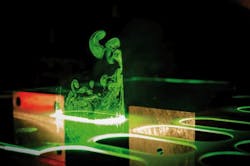Ultrafast lasers enable techniques for the manufacturing of tomorrow
Aachen, Germany - Laser technology plays an outstanding role in the German economy, as approximately 40 percent of beam sources sold worldwide and 20 percent of laser systems for material processing come from Germany. And when it comes to laser use in manufacturing, German companies are at the forefront.
To preserve and build on these strengths, the German Federal Ministry of Education and Research (BMBF) founded the Digital Photonic Production (DPP) research campus, which will be funded by €2 million ($2.1 million) annually for up to 15 years. In a collaboration that brings together RWTH Aachen University, the Fraunhofer Institute for Laser Technology (ILT), and industrial partners, the Femto Photonic Production joint research project intends to lay the foundations for the use of ultrafast lasers in industrial manufacturing processes.
The DPP research campus establishes a new form of long-term and systematic cooperation between the university, the Fraunhofer-Gesellschaft, and 28 partners from industry all under one roof. The goal of this collaboration is the complementary pooling of different resources with a new focus on joint application-oriented basic research. As regards content, the DPP research campus concentrates on researching new methods and fundamental physical effects for the use of lasers as a manufacturing tool, particularly for the major topics of the future, such as energy, health, mobility, security, and information and communications technology.
Three projects by researchers at RWTH Aachen University in cooperation with Fraunhofer ILT and various industrial partners have already been approved within the Aachen research campus: Nano Photonic Production for researching novel VCSEL beam sources; Direct Photonic Production for further developing additive manufacturing methods; and Femto Photonic Production with a main focus on further developing ultrafast laser manufacturing methods.
Launched in October 2014, the Femto Photonic Production project is scheduled to run for five years. Led by RWTH Aachen University, it is designed to yield a better understanding of the fundamentals involved in the processing of modern materials. The research activities focus particularly on materials with large electronic band gaps—in other words, with high transparencies—such as glass, sapphire, and diamond.
Ultrafast lasers represent a class of optical processing systems capable of generating new functionalities on materials and components. However, the fundamental processes at work in the interaction between ultrashort laser pulses and the absorption effects in transparent materials are still not sufficiently understood today. Many of the materials being researched in the project—and which will be relevant for future applications—are transparent, which means that they can only be processed using very complex laser processes. The core of the joint project is the fundamental analysis, simulation, and description of the interaction of laser radiation with transparent materials.
Based on these fundamental results, the optimum performance parameters for the various laser classes along with the adjusted optics and system solutions will be determined for all relevant material classes and subsequently evaluated in experimental studies together with the project's industrial partners. One of the goals of these research activities is to make the laser processing of electronic components a viable option for the manufacturing of displays, modern LEDs, and power transistors.
Through the close cooperation of experts from RWTH Aachen University and Fraunhofer ILT with the beam source manufacturers TRUMPF, EdgeWave, and Amphos, and the system providers 4Jet, LightFab, and Pulsar Photonics, project work can draw on a machine and system pool unparalleled anywhere in the world. This allows scientists and engineers from research and industry to work together productively on topics and interests that are common to them, which is very much in the spirit of cooperation behind the Digital Photonic Production research campus.



